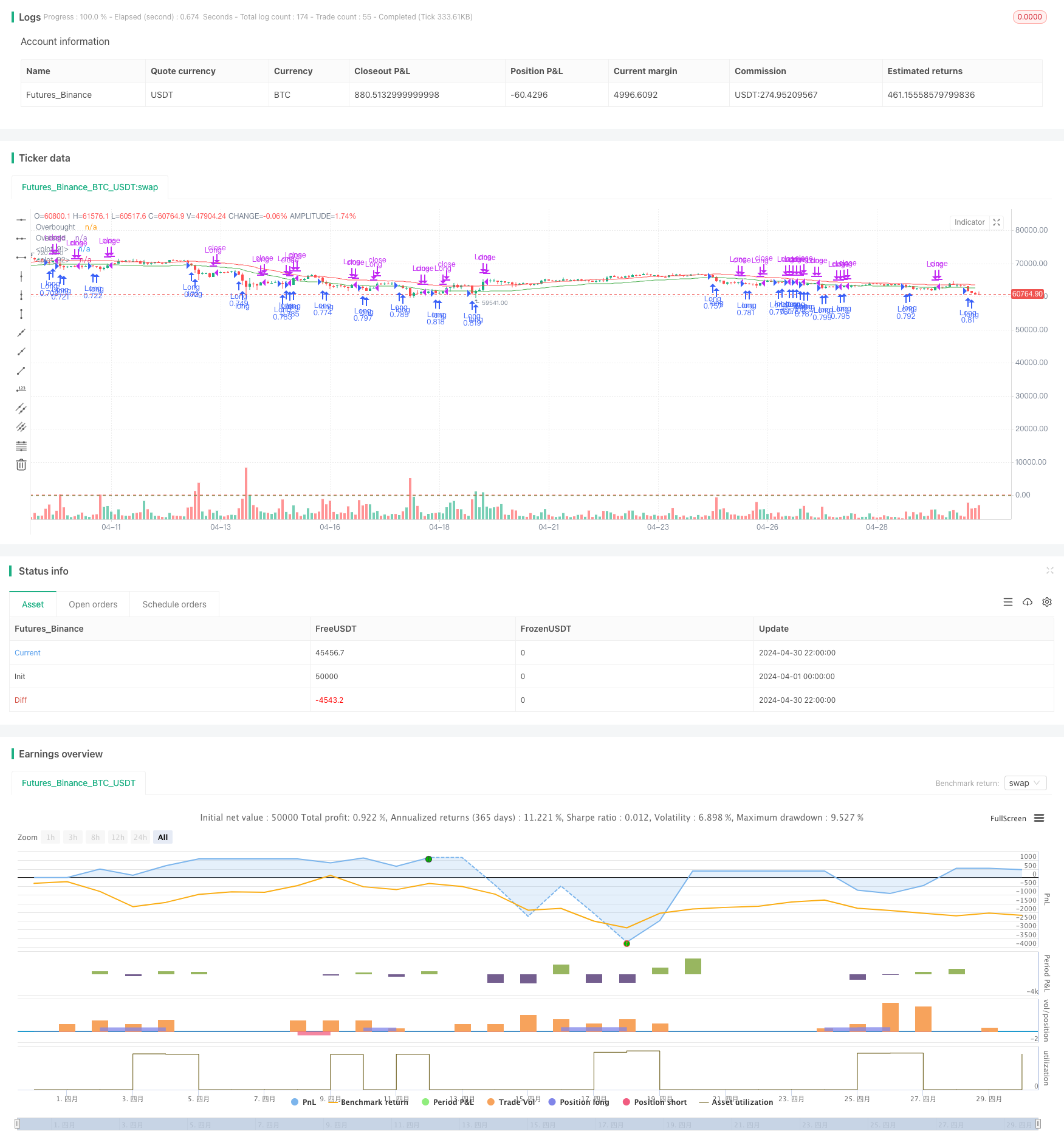
概述
本策略采用CCI、RSI和肯特纳通道(KC)三种技术指标,结合趋势过滤器,实现在AUDNZD和GBPNZD货币对上的多空双向交易。策略通过CCI和RSI来判断超买超卖情况,KC作为止损止盈的参考依据,同时使用移动平均线作为趋势过滤,在顺势的情况下进行开仓操作。该策略已经在过去5年的历史数据上进行了回测,取得了稳定的收益。
策略原理
- 计算CCI、RSI和KC指标。KC上轨为中线加上ATR,下轨为中线减去ATR。
- 根据输入参数选择移动平均线类型(SMA、EMA、SMMA、CMA或TMA)和趋势过滤方法(关闭、正向或反向)。
- 多头开仓条件:允许做多、CCI<超卖线、收盘价50周期均量*倍数、当前无多头仓位。
- 空头开仓条件:允许做空、CCI>超买线、收盘价>KC上轨、RSI>超买线、成交量>50周期均量*倍数、当前无空头仓位。
- 多头平仓条件:CCI>0。空头平仓条件:CCI。
- 开仓时发出警报,平仓时也发出警报。
策略优势
- 结合多个指标进行综合判断,提高信号准确性。
- 采用趋势过滤方法,可以根据市场趋势灵活调整,顺势而为。
- 移动平均线类型可选,适应不同的市场特点。
- 已经过长时间的历史数据验证,稳定性好,适合长期使用。
- 双向交易,适应各种行情,获利机会多。
- 自动化程度高,不需要人工干预,省时省力。
策略风险
- 缺乏传统的止损止盈,遇到极端行情可能出现较大回撤。
- 在震荡市可能出现频繁开平仓,交易成本增加。
- 使用了相对较短的CCI周期,可能出现噪音信号。
- 在趋势不明朗或市场波动加大时,趋势过滤作用有限。
- 固定仓位,不能自适应市场波动率的变化。
策略优化方向
- 可以考虑增加移动止损或固定点数止损,控制单笔交易风险。
- RSI和CCI的参数可以进一步优化,以减少噪音信号。
- 可以考虑引入波动率指标如ATR,根据市场波动调整仓位和止损。
- 增加更多货币对,并根据每个品种特点单独优化参数。
- 尝试引入机器学习等人工智能技术,自适应优化参数。
总结
该策略采用了多个经典指标,trading view上编写和回测都比较方便。回测效果不错,但实盘中还需注意控制风险,调整参数。建议先小资金测试,积累经验后再逐步加大投入。机械化程度高,适合稳健型投资者长期使用。
策略源码
/*backtest
start: 2024-04-01 00:00:00
end: 2024-04-30 23:59:59
period: 2h
basePeriod: 15m
exchanges: [{"eid":"Futures_Binance","currency":"BTC_USDT"}]
*/
//@version=5
strategy('CCI Strategy with Trend Filter AUDNZD, GBPNZD', overlay=true, default_qty_type=strategy.cash, default_qty_value=50000, commission_value=0.0005, slippage=2, initial_capital=10000)
// State variables to ensure one entry per signal
var bool isLongOpen = false
var bool isShortOpen = false
// Input Parameters for allowing long and short trades
allowLong = input(true, title='Allow Long Trades')
allowShort = input(true, title='Allow Short Trades')
// Trend Filter Inputs
maType = input.string(title='MA Type', options=['OFF', 'SMA', 'EMA', 'SMMA', 'CMA', 'TMA'], defval='OFF')
trendFilterMethod = input.string(title='Trend Filter Method', options=['OFF', 'Normal', 'Reversed'], defval='OFF')
maLength = input(14, title='MA Length')
// Other Input Parameters
lengthKC = input(30, title='Keltner Channels Length')
multKC = input(0.7, title='Keltner Channels Multiplier')
lengthCCI = input(5, title='CCI Length')
overboughtCCI = input(75, title='CCI Overbought Level')
oversoldCCI = input(-75, title='CCI Oversold Level')
rsiPeriod = input(30, title='RSI Period')
rsiOverbought = input(60, title='RSI Overbought Level')
rsiOversold = input(60, title='RSI Oversold Level')
volumeMultiplier = input.float(0, title='Volume Multiplier', step=0.1, minval=0)
// Define Moving Averages
var float maValue = na
if maType == 'SMA'
maValue := ta.sma(close, maLength)
else if maType == 'EMA'
maValue := ta.ema(close, maLength)
else if maType == 'SMMA'
float initialSMMA = ta.sma(close, maLength)
maValue := na(maValue[1]) ? initialSMMA : (maValue[1] * (maLength - 1) + close) / maLength
else if maType == 'CMA'
float firstSMA = ta.sma(close, maLength)
float secondSMA = ta.sma(close, maLength)
maValue := na(maValue[1]) ? firstSMA : (firstSMA + secondSMA - maValue[1]) / 2
else if maType == 'TMA'
maValue := ta.sma(ta.sma(close, math.round(maLength / 2)), math.round(maLength / 2) + 1)
// Entry Conditions with Trend Filter
longCondition = allowLong and (trendFilterMethod == 'OFF' or trendFilterMethod == 'Normal' and close > maValue or trendFilterMethod == 'Reversed' and close < maValue)
shortCondition = allowShort and (trendFilterMethod == 'OFF' or trendFilterMethod == 'Normal' and close < maValue or trendFilterMethod == 'Reversed' and close > maValue)
// Keltner Channels
typicalPrice = hlc3
middleLine = ta.sma(typicalPrice, lengthKC)
range_1 = multKC * ta.atr(lengthKC)
upperChannel = middleLine + range_1
lowerChannel = middleLine - range_1
// CCI
cci = ta.cci(close, lengthCCI)
// RSI
rsi = ta.rsi(close, rsiPeriod)
// Volume
volCondition = volume > ta.sma(volume, 50) * volumeMultiplier
// Combined Entry Conditions with Trend Filter and state check
longCondition := longCondition and cci < oversoldCCI and low < lowerChannel and rsi < rsiOversold and volCondition and not isLongOpen
shortCondition := shortCondition and cci > overboughtCCI and high > upperChannel and rsi > rsiOverbought and volCondition and not isShortOpen
// Execute orders at the open of the new bar after conditions are met
if longCondition
strategy.entry('Long', strategy.long)
alert('LicenseID,buy,AUDNZD,risk=1')
isLongOpen := true
if shortCondition
strategy.entry('Short', strategy.short)
alert('LicenseID,sell,AUDNZD,risk=1')
isShortOpen := true
// Exit Conditions and Alerts
longExitCondition = cci > 0
shortExitCondition = cci < 0
if (longExitCondition and isLongOpen)
strategy.close('Long')
alert('LiceneseID,closelong,AUDNZD')
isLongOpen := false
if (shortExitCondition and isShortOpen)
strategy.close('Short')
alert('LicenseID,closeshort,AUDNZD')
isShortOpen := false
// Plotting
plot(upperChannel, color=color.new(color.red, 0), linewidth=1)
plot(lowerChannel, color=color.new(color.green, 0), linewidth=1)
hline(overboughtCCI, 'Overbought', color=color.red)
hline(oversoldCCI, 'Oversold', color=color.green)
相关推荐